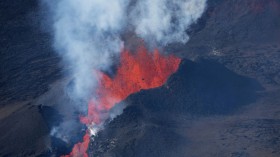Apparently, there are earthquakes happening on Mars called "Mars-quakes." However, what's more surprising is the finding of a new study suggesting that Martian earthquakes might potentially produce energy to support life.
Mars-quakes may be able to produce energy to sustain life due to the trapped hydrogen in Martian rocks that are being freed into the atmosphere during grinding or movements of the rocks, a new study suggests.
In order to come up with their findings, the researchers from Yale, the University of Aberdeen and the Brock University who led the study, focused on analyzing rock formations in regions where there are identified fault lines specifically in the Outer Hebrides in the coast of Scotland. This is where their presumption that grinding rocks on the red planet release trapped hydrogen. On Earth, earthquakes can be devastating, but it can mean the opposite on the red planet, according to a report.
Researchers say that previous studies on Earthquakes suggest that hydrogen is produced during the movement of the ground. The hydrogen emission is enough to support the growth of microorganisms, according to one of the researchers.
Though it won't apply to humans and animals, certain microorganisms may indeed thrive from hydrogen released from earthquakes. Experts agree that the oxidation of hydrogen is capable of generating just enough energy for bacteria deep under the Earth to thrive. This is the basis for studying "Mars-quakes."
"Mars is not very seismically active, but our work shows that 'Marsquakes' could produce enough hydrogen to support small populations of microorganisms, at least for short periods of time," Yale geologist Sean McMahon said in a statement. "This is just one part of the emerging picture of the habitability of the Martian subsurface, where other sources of energy for life may also be available," McMahon added.
The researchers also stated that to find evidence of life forms on Mars, they will have to examine rocks and minerals buried deep in the ground that was later brought upwards to the surface by erosions. These rocks may emit hydrogen gas.
But in order to do that, researchers will need data about the seismic activities on the red planet. This is where NASA's expertise comes into play. By 2018, NASA's unmanned mission to Mars plans on studying earthquakes on the red planet that will then provide new information about Mars-quake.
"NASA has plans to measure seismic activity on Mars during its 2018 InSight mission, and our data will make those measurements all the more interesting," study co-author John Parnell from the University of Aberdeen in Scotland said in an interview.
Read More:
Elon Musk's Mars Colonization Plan -- What We Know So Far
Alien 'Snake' Spotted in Mars NASA Photo, Conspiracy Theorists Claim
Mars Used to Support Life Longer than Previously Thought, Study Says
© 2024 NatureWorldNews.com All rights reserved. Do not reproduce without permission.





